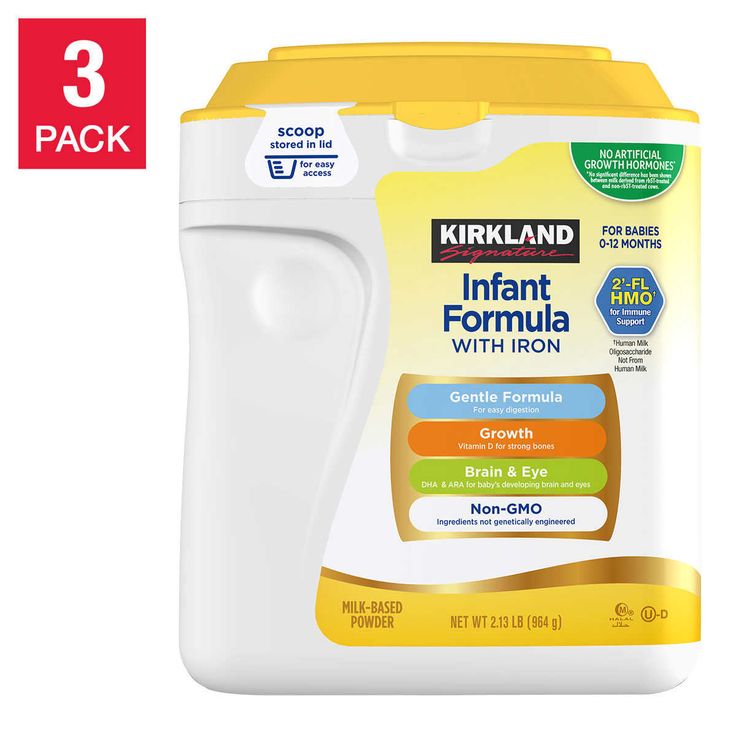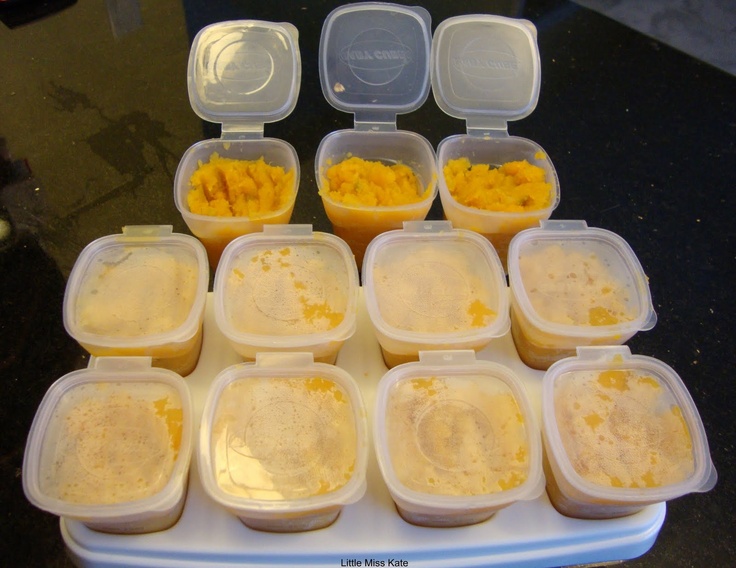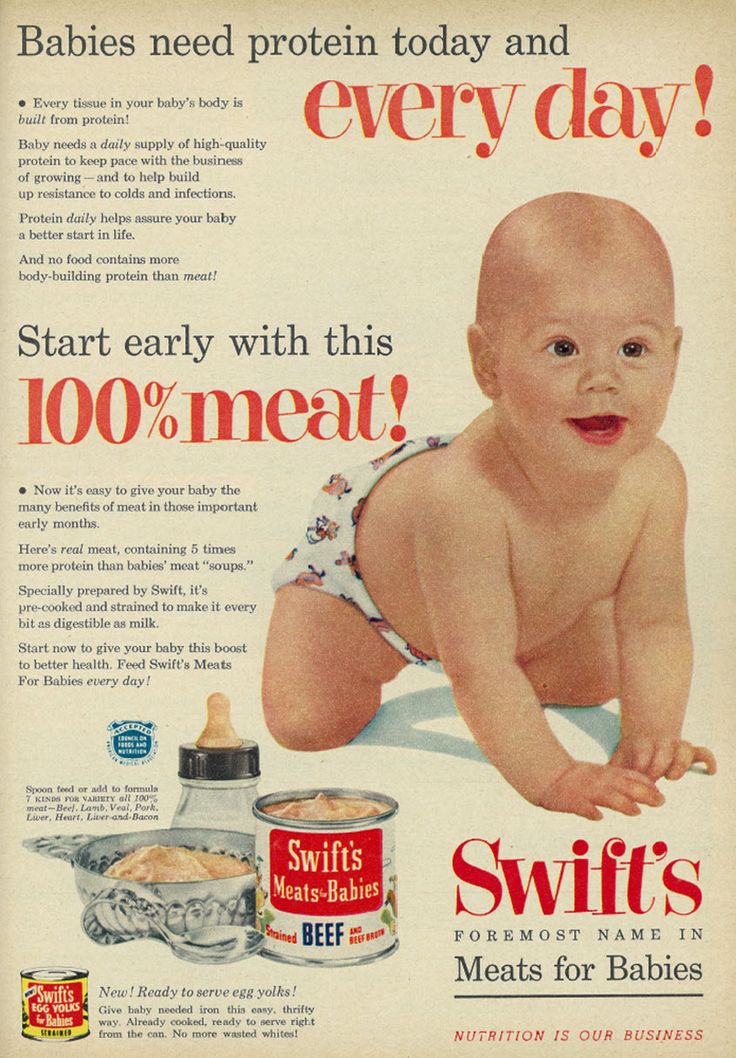Can u mix baby food with formula
What to Feed Your Baby: Formula, Breast Milk and Beyond
Introducing a baby to solid food is exciting and scary. Often parents have so many questions: What do you feed them first? When do you start them on solids? How much do you feed them? How often do you feed them? So many questions, particularly when you're sleep-deprived state. To help answer all these questions, here's a baby food guide (with recipes!) for kids 4 months and older.
Note: Babies should NOT have the following until they are 1 year old: cow's milk, honey (can cause botulism), nuts/hard foods, shellfish and unpasteurized cheeses. Their digestive systems are still developing, and certain foods can be obvious choking hazards or cause health issues.
4 to 6 months
Start your baby on solids with simple, basic foods such as puréed fruits and vegetables and iron-fortified baby cereal. Since babies are used to breast milk or formula, mix puréed foods with breast milk or formula to pique their interest. You’ll want the food to be runny for the first few feedings. You can gradually increase the thickness as time goes on and your baby becomes more comfortable with texture. Introduce one new food every three to four days so you can be aware of any allergies that might show up. This chart is a great resource for how much to feed your baby.
Most vegetable/fruit purées follow the same “recipe.” Simply steam or bake a vegetable or fruit until the food is soft. Let cool and place in a food processor or blender to blend with breast milk, formula or water until smooth. An efficient way to make baby food is to make big batches of one vegetable or fruit purée at a time and freeze them in ice cube trays for up to two months. When you are ready to serve, you can defrost a cube of purée. Mix with other cubes for more complex combinations as your child’s diet evolves.
Sweet potatoes or squash make a delightful first food.
Sweet potato purée
Ingredients:
- 1/2 cup sweet potato, peeled and cut into 1-inch cubes
- 2 oz breast milk, formula or water
Steps:
1.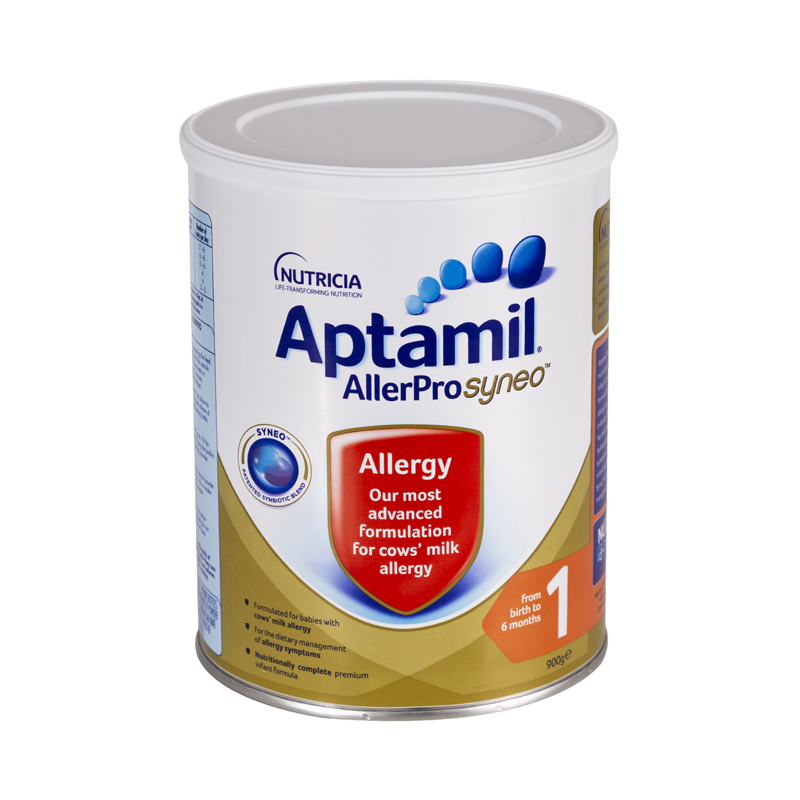 Preheat the oven to 425 degrees Fahrenheit.
Preheat the oven to 425 degrees Fahrenheit.
2. Spread the sweet potatoes on a sheet pan.
3. Roast for 20 minutes or until soft. Remove from oven and let cool.
4. Blend the sweet potatoes with breast milk, formula or water until smooth. Add more liquid as necessary.
5. Store in airtight container for three days in fridge or one month in freezer.
For a more complex food, combine roasted carrots, baked apples and roasted butternut squash. You’ll want to introduce each of these foods separately but once your baby has done well with them, mix them for a different flavor. Blend with breast milk, formula and water to keep the purée smooth.
Roasted carrot, baked apple and roasted butternut squash purée
Ingredients:
- 1/2 cup carrots, cut into 1-inch pieces
- 1/2 cup apple, cut into 1-inch pieces
- 1/2 cup butternut squash, cut into 1-inch pieces
- 4 ounces breast milk, formula or water
Steps:
1.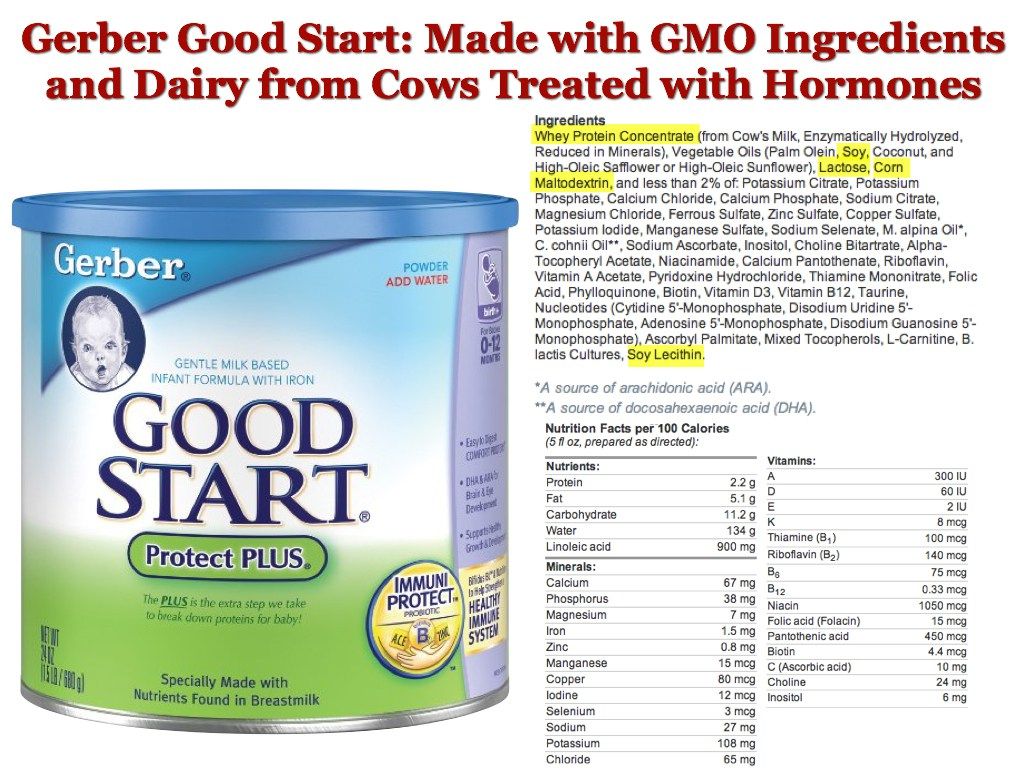 Preheat the oven to 375 degrees Fahrenheit.
Preheat the oven to 375 degrees Fahrenheit.
2. Spread the carrots, apples and butternut squash on a sheet pan.
3. Roast for 20 minutes or until soft. Remove from oven and let cool.
4. Blend the roasted carrots, baked apples and roasted butternut squash with breast milk, formula or water until smooth. Add more liquid as necessary.
5. Store in airtight container for three days in fridge or one month in freezer.
6 to 8 months
At this point, your little one is getting a hang of eating and his or her tastebuds are developing. You can start to introduce yogurts, puréed meats and legumes (beans, chickpeas, edamame, etc) to your baby's diet.
Avocados are a favorite first food due to their soft texture and delightful flavor and combined with edamame, they make a tasty treat. Mash avocados with mashed edamame in a blender or by hand for a chunkier texture.
Avocado and edamame purée
Ingredients:
- 1 avocado
- 1/2 cup cooked edamame
- 2-4 ounces breast milk, formula or water
Steps:
1.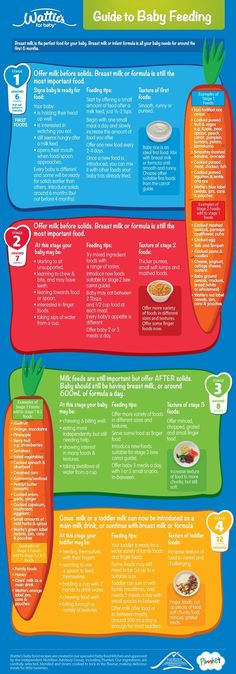 Blend avocado and cooked edamame with breast milk, formula or water until smooth. Add more liquid as necessary.
Blend avocado and cooked edamame with breast milk, formula or water until smooth. Add more liquid as necessary.
2. Store in airtight container for three days in fridge or one month in freezer.
For a heartier meal, steamed spinach, baked apples with cinnamon and peas are a great combination that will please baby’s taste buds.
Spinach, apple and pea purée
Ingredients:
- 1/2 cup spinach
- 1/2 cup apple, cut into 1-inch pieces
- 1 teaspoon cinnamon
- 1/2 cup peas (fresh or frozen)
- 4 ounces breast milk, formula or water
Steps:
1. Lightly steam spinach in a vegetable steamer until soft.
2. Place apple with cinnamon in a saucepan with a few tablespoons of water and cook until soft.
3. Add peas to the apple and cinnamon mixture and cook until soft.
4. Blend the spinach, apples and peas with breast milk, formula or water until smooth. Add more liquid as necessary.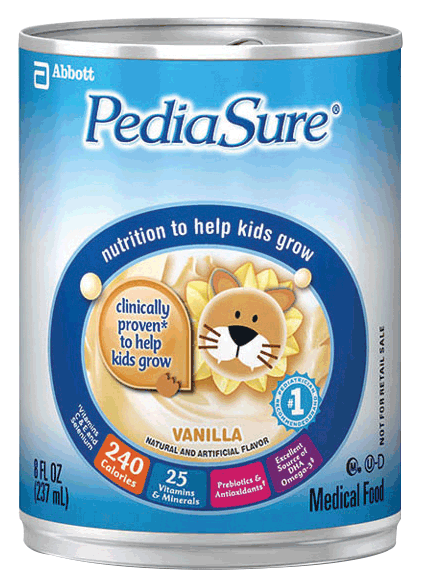
5. Store in airtight container for three days in fridge or one month in freezer.
8 to 10 months
Baby’s pincer grasp is usually strong by now; you're ready for finger foods. No need to make this phase complicated. Start with softer foods that can be easily mashed by little hands but held steady between tiny fingers. Peas, diced blueberries, bananas, steamed zucchini, baked apples and diced avocado are favorites along with small chunks of cheese, diced chicken and cereal (think Cheerios). Alice and Lois have a great list of baby finger foods and bonus smoothie pop recipes.
10 to 12 months
Babies are eating more combinations at this point; most can eat almost everything you eat. A favorite baby food is hummus. Add some extra ingredients to make it more exciting. Blueberries and zucchini are great additions while broccoli, carrots, sweet potatoes and sun-dried tomatoes can break up basic garbanzo beans and olive oil.
Blueberry, rosemary, zucchini, garbanzo bean hummus
Ingredients:
- 1/4 cup blueberries
- 1/2 cup garbanzo beans, strained and drained
- 1/2 cup zucchini, cut into 1-inch pieces and lightly steamed
- 1 teaspoon rosemary, minced
- 1 tablespoon olive oil
Steps:
1.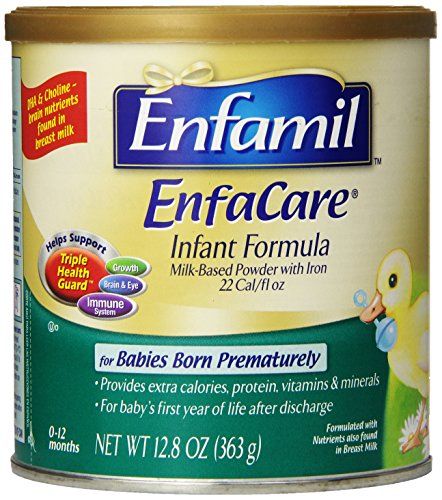 Combine blueberries, garbanzo beans, zucchini and rosemary with olive oil in food processor and pulse. Scrape down the sides and blend until you have reached the desired consistency.
Combine blueberries, garbanzo beans, zucchini and rosemary with olive oil in food processor and pulse. Scrape down the sides and blend until you have reached the desired consistency.
2. Serve with pita bread or crackers.
3. Store in airtight container for three days in fridge or one month in freezer.
Toddlers and beyond
Toddlers have usually moved beyond the basic purée but don’t have very well-developed palates. Also, the concern for choking is still big. Suggestion: smoothies. They're a great way to pack in some nutrients. Popsicles can also be made with fresh fruit and yogurt for a refreshing treat.
Strawberry oatmeal smoothie
Ingredients:
- 1 banana
- 1 cup frozen strawberries
- 1/2 cup rolled oats
- 1 cup milk (cow, almond, soy)
- 1 teaspoon chia seeds
Steps:
1. Combine banana, frozen strawberries, rolled oats, milk and chia seeds in a blender. Blend until smooth.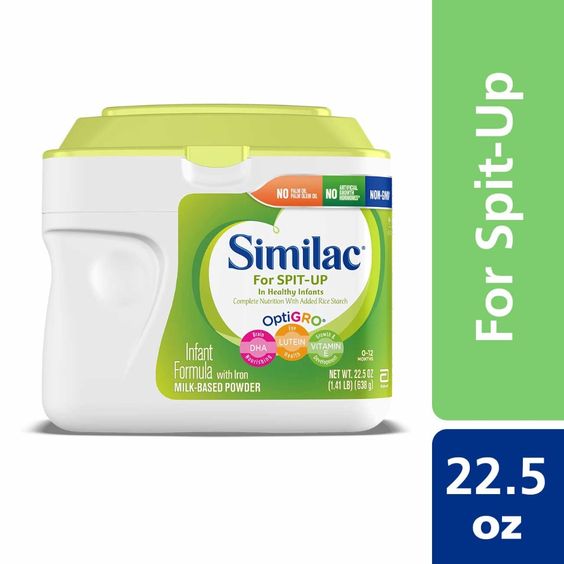
2. Serve immediately.
Formula Feeding FAQs: Starting Solids and Milk (for Parents)
Whether you plan to formula feed your baby from the start, want to supplement your breast milk with formula, or are switching from breast milk to formula, you probably have questions.
Here are answers to some common questions about formula feeding.
When Can My Baby Try Solid Foods?
Doctors recommend waiting until your baby is about 6 months old to start solid foods. Some babies may be ready for solids sooner than 6 months, but wait until your baby is at least 4 months old.
Babies who are ready to eat solids foods:
- are interested in foods (for example, they may watch others eat, reach for food, and open their mouths when food is near)
- hold up their heads well, and sit up with little or no help
- don't push food of their mouth (which is a natural tongue reflex that disappears when babies are 4–6 months old)
- usually weigh twice their birth weight, or close to it
Talk to your doctor about the right time to start solid foods.
How Do I Introduce Solid Foods?
When the time is right, start with a single-grain, iron-fortified baby cereal. Start with 1 or 2 tablespoons of cereal mixed with breast milk, formula, or water. Feed your baby with a small baby spoon. Don’t add cereal to a baby's bottle unless your doctor recommends it.
When your baby gets the hang of eating the first food, introduce other foods from all food groups, such as puréed meats, fruits, vegetables, grains, beans, and yogurt. Wait a few days between introducing new foods to make sure your baby doesn't have an allergic reaction.
You can include foods that are more likely to cause allergies — such as peanuts, eggs, cow’s milk, seafood, nuts, wheat, and soy — among the foods you introduce to your infant. Waiting to start these foods does not prevent food allergies.
Talk to your doctor before giving foods that contain peanuts if your baby has severe eczema or an egg allergy, as these conditions make an allergy to peanuts more likely. Eating peanut-containing foods early on may lower a child’s chances of developing a peanut allergy. But your doctor will need to decide if you can give peanuts to your baby, and the safest way to do it. Usually, this requires allergy tests.
Eating peanut-containing foods early on may lower a child’s chances of developing a peanut allergy. But your doctor will need to decide if you can give peanuts to your baby, and the safest way to do it. Usually, this requires allergy tests.
Should We Avoid Some Foods?
Yes, don’t give your baby:
- foods with added sugars or no-calorie sweeteners
- high-sodium foods
- honey until after the first birthday. It can cause botulism in babies.
- unpasteurized juice, milk, yogurt, or cheese
- regular cow's milk or soy beverages instead of breast milk or formula before 12 months. It’s OK to offer pasteurized yogurt and cheese.
- foods that may cause choking, such as hot dogs, raw carrots, grapes, popcorn, and nuts
Always supervise your child when eating. Make sure your child is sitting up in high chair or other safe place.
When Can My Baby Have Cow's Milk?
Before their first birthday, babies still need the nutrients in breast milk or formula.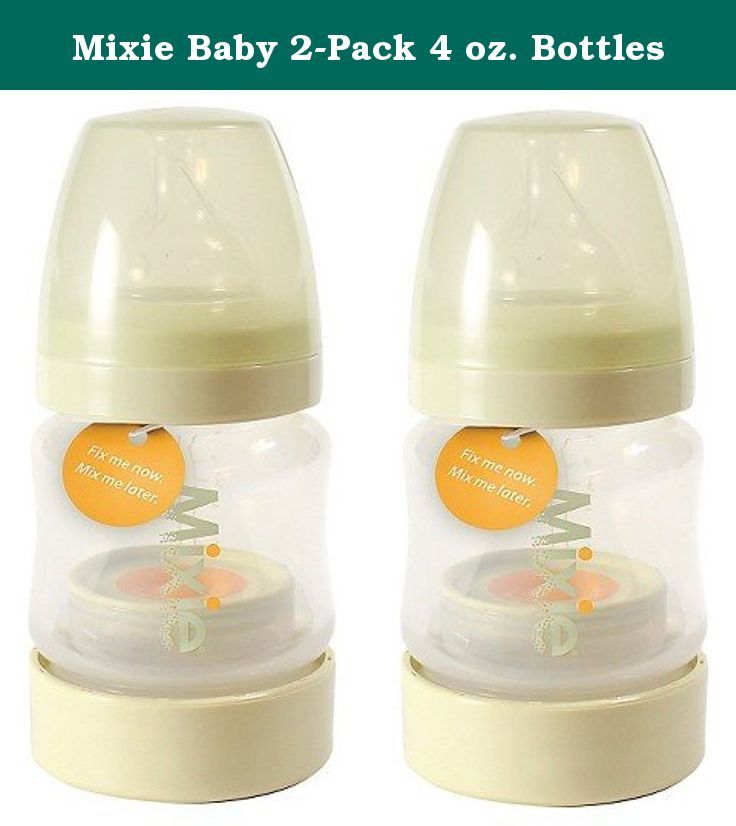 But after that, they’re ready to switch to cow's milk.
But after that, they’re ready to switch to cow's milk.
Most kids under age 2 should drink whole milk. If a toddler is overweight or there is a family history of obesity, high cholesterol, or heart problems, your doctor might recommend switching to reduced fat (2%) milk.
If your child can’t drink cow’s milk, choose an unsweetened soy beverage fortified with calcium and vitamin D. Other milk alternatives, like almond, oat, rice, or coconut milk, have less protein and may not be fortified.
How Do We Switch to Cow’s Milk?
You can switch your baby from formula to whole milk by replace bottles of formula with bottles — or sippy cups — of milk. By 1 year old, your baby should be eating a variety of solid foods and drinking about 16 to 24 ounces (480–720 milliliters) of milk per day.
When Can I Start Giving My Baby Water and Other Drinks?
In their first 6 months, healthy babies drinking enough formula usually don't need extra water. Once your baby is eating solid foods, you can offer a small amount of water between feedings, up to 4–8 ounces a day.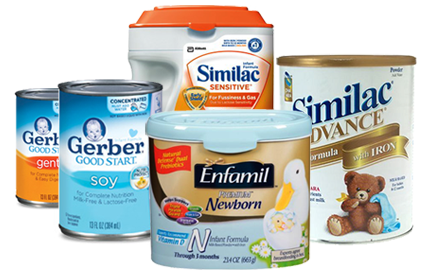
Water that has fluoride helps prevent tooth decay. If your water does not have fluoride, talk to your doctor or dentist about fluoride drops.
Do not give juice to babies younger than 12 months. After your child’s first birthday, limit 100% fruit juice to no more than 4 ounces a day. Always serve juice in a cup, not in a bottle. Don’t give your child sugar-sweetened beverages, including soda, juice drinks, sports drinks, and flavored milks.
Reviewed by: Mary L. Gavin, MD
Date reviewed: November 2021
How to introduce new formula to a baby | Changing from one mixture to another: scheme
09/06/2017 Rassadina Zinaida Vladimirovna
Articles
How do I switch my baby to another formula?
The diet and diet of a formula-fed baby require special attention and constancy. The diet and diet of a formula-fed baby require special attention and constancy. However, quite often there are situations when transferring a child to another mixture becomes a necessity. In this article, we will tell you how to make the transition to a new diet comfortable and safe for your crumbs.
However, quite often there are situations when transferring a child to another mixture becomes a necessity. In this article, we will tell you how to make the transition to a new diet comfortable and safe for your crumbs.
Why shouldn't the mixture be changed frequently?
The reasons for the transfer of an artificial child from one mixture to another must be strictly argued. Usually, the pediatrician gives recommendations on changing the diet if the child's health condition requires it. Frequent and unreasonable transitions to a new mixture is a real stress for the child's body, such jumps can provoke digestive problems in the baby.
Reasons for switching a baby to new formula
Situations that require replacement of infant formula with another one may be the following:
- symptoms of allergy to the first mixture;
- the need to introduce a therapeutic mixture, in connection with the detection of any disease in a child;
- the need to replace the therapeutic mixture with an adapted one in the event that the baby has eliminated the disease or condition in which it was prescribed;
- milk protein intolerance or lactase deficiency;
- refusal of the child from the usual mixture, insufficient weight gain;
- the need to transition to a new stage of nutrition in connection with reaching a certain age (6, 12 months).
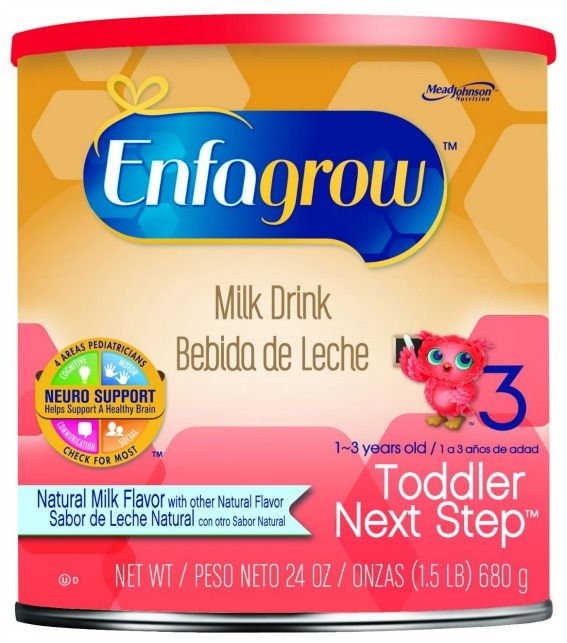
Switching to a new diet: how long does it take?
Transferring a baby from one mixture to another takes up to two weeks. During this time, the following changes are possible in the child's condition:
- change in stool - such a reaction is considered temporary and is not a reason for refusing to transfer;
- change in the child's appetite;
- changes in the mood of the crumbs.
In order to make sure that the new food suits your child, at least a month should pass. Carefully monitor the baby's reaction: appetite, activity, sleep, digestion, skin condition. If, after feeding with a new mixture, the child becomes restless, sleep worsens, rashes or other allergic reactions appear on the skin, immediately consult a pediatrician for advice.
What is the total daily amount of formula and the amount of one serving for a IV baby?
The first thing they are guided by when determining the sufficiency and quality of nutrition of an artificial baby is the monthly indicators of increased growth and weight gain.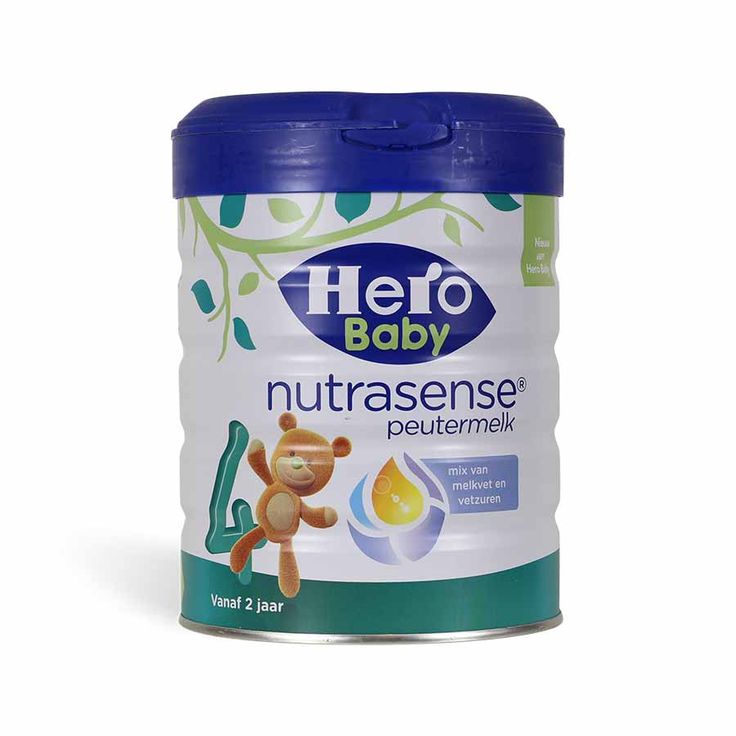 According to current standards, for the first 2 months of life, a child should consume a volume equal to 1/5 of his weight per day.
According to current standards, for the first 2 months of life, a child should consume a volume equal to 1/5 of his weight per day.
Example: baby weight 3 kg - 600 ml (3000/5=600) - the total amount of formula per day.
The norm of formula for children of the first year of life:
- from 2 to 4 months is 1/6 of body weight,
- 4 to 6 - 1/7,
- after 6 months -1/8-1/9.
The size of 1 serving is determined according to the following principle: divide the total amount of food by the frequency of feeding. It is possible that in one of the feedings the child refuses to eat up the prescribed norm, and the next time he drinks a little more than usual. Such deviations in one direction or another are quite acceptable.
Healthy transition rules
Experts recommend a phased transition to a new diet within one week, the frequency of feeding is 7 times:
1 day: at the first feeding - only the old mixture, the second feeding - a new one, the rest of the feedings - the old mixture. Monitor the child's condition, there should be no anxiety and sleep disturbances;
Monitor the child's condition, there should be no anxiety and sleep disturbances;
Day 2: new formula - second and fourth feedings;
Day 3: new formula - second, fourth and sixth feedings;
Day 4: new formula - first, second, fourth and sixth feedings;
Day 5: new formula - first, second, third, fourth and sixth feedings;
Day 6: new formula - every feeding except the fifth;
Day 7: every feeding - new formula.
Such a smooth transition will help the child's body easily adapt to a new diet, which will prevent digestive problems or other negative consequences for the baby's health.
Author: Rassadina Zinaida Vladimirovna Pediatrician, experience - 14 years
Can breast milk be mixed with formula, cereals and other foods?
— Olesya Vladimirovna, tell us what is mixed feeding? What are the main pros and cons of this type of nutrition for digestion and child development?
— We can talk about mixed feeding if the baby receives both breast milk and adapted milk formula. Most often, the need for this type of nutrition is due to poor weight gain of the baby with a lack of mother's milk. Also, supplementary feeding in the form of a mixture may be relevant during the hospitalization of the mother, her forced departure or going to work.
Most often, the need for this type of nutrition is due to poor weight gain of the baby with a lack of mother's milk. Also, supplementary feeding in the form of a mixture may be relevant during the hospitalization of the mother, her forced departure or going to work.
Pediatricians distinguish two types of such nutrition: alternate and sequential.
With alternating, as its name already implies, in one feeding the baby receives mother's breast, and in another or even several subsequent ones - a mixture.
In the sequential version, the baby suckles until it is completely empty, and if he shows anxiety because he has not eaten, then he is supplemented with formula.
Let's talk about the benefits of this diet:
- First, with mother's milk, the child receives immunoglobulins , that is, protection against infection.
- Secondly, the mixture provides saturation, weight gain and supply of the body with vitamins and microelements.
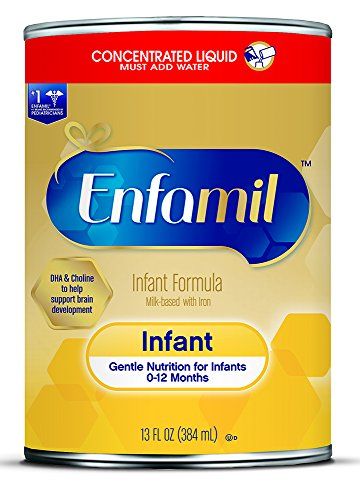 Many blends are rich in L-carnitine , a weight-gaining compound.
Many blends are rich in L-carnitine , a weight-gaining compound. - Mixed feeding maintains close contact between mother and baby through attachment to the breast, which is important for the comfort of the baby.
But the disadvantages are inevitable:
- Formula milk may, although not always, increase the likelihood of constipation.
- Often there are difficulties with the selection of a mixture that the child will eat with pleasure.
- And, finally, financial expenses. A good mixture imposes certain costs on the family.
- Let's talk about blending. Can I mix different portions of breast milk? And if so, how to do it right?
— Each portion of breast milk, even if it is small, should be stored in a separate sterile container in the refrigerator for no more than a day or frozen - always labeled - for six months.
— Can expressed milk that has been stored for some time be mixed with fresh milk?
- This option is theoretically possible, but I don't see any reason for it.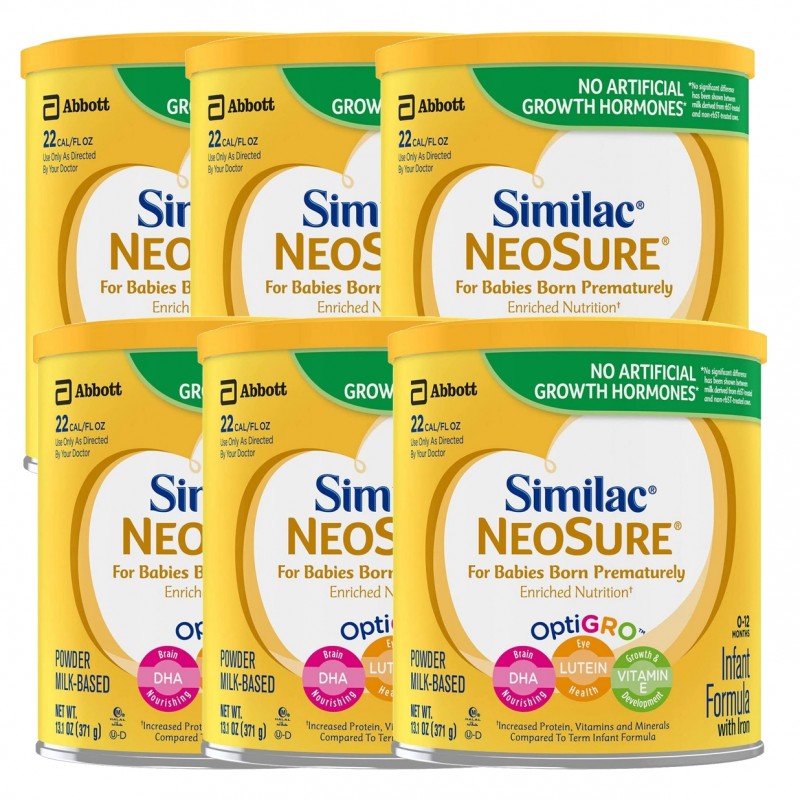 Why express fresh milk and mix it with "old" milk? In this case, it is better to breastfeed the baby, and then supplement the previously expressed product.
Why express fresh milk and mix it with "old" milk? In this case, it is better to breastfeed the baby, and then supplement the previously expressed product.
- Can formula be mixed with breast milk? Do these mixtures need to be diluted with water? Can it be diluted partly with water and partly with milk? And if so, how to do it right?
— To be honest, I don't understand why you mix breast milk with formula. If the mother has some milk, then you need to breastfeed the baby, and then supplement it with a mixture. Mixing formula and milk in one bottle is completely impractical.
- Is it possible to mix cereals with breast milk?
- But you can breed porridge with breast milk. If there is excess milk that the mother can express after feeding, then it is permissible to add it to instant (not requiring cooking) cereals. The familiar taste can make it easier for your baby to introduce a new food.
— Is there a difference between breastfeeding a baby with supplemental formula and breastfeeding with formula all at once?
- I'm still against diluting formula with breast milk: I just don't see the point in it.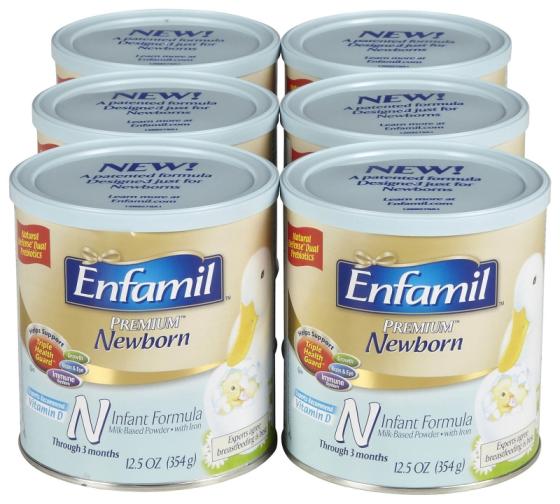 If there is 30 ml of milk, you can feed it to the child, and then supplement it with a good adapted milk formula.
If there is 30 ml of milk, you can feed it to the child, and then supplement it with a good adapted milk formula.
- Breast milk porridge - why do questions arise about its preparation?
— Why do such questions arise? Because some mothers have excess milk, they express it and understand that this is a valuable and important product. So, they want to use it for breeding cereals. In fact, the composition of instant cereals has already been adapted to the needs of the child, and mother's milk in this case can only add the usual taste.
— Can cooking porridge with breast milk make it easier to introduce complementary foods?
— What kind of porridge are we talking about? If about instant, that is, bred, then this is already a full-fledged and rich in vitamins and microelements food. You can add some breast milk to it for taste. If the mother decides to cook porridge from crushed cereals and she has expressed breast milk, then it will fit, of course, much better than cow's.
— How to cook porridge with breast milk?
- Just like on cow's - pour the cereal with milk and simmer over low heat until cooked. But this destroys part of the nutrients of breast milk. Therefore, you can boil the porridge in water, cool it a little and then add warm breast milk.
— At what age can you feed your baby cereals with breast milk?
- We introduce porridge as a second complementary food, after hypoallergenic vegetables settle in the child's diet - unless your pediatrician recommends otherwise. Pediatricians advise giving milk porridge to children, which are diluted with water, and dairy-free porridge can be mixed with breast milk if the mother has the opportunity to express after feeding.
- Can MAMAKO ® Premium goat milk formula be mixed with breast milk for mixed feeding?
- MAMAKO ® Premium contains goat's milk, which is better digested and absorbed by the child's body than cow's, which is the basis of many children's products.